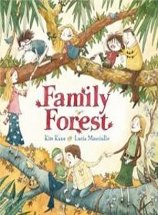Family forest by Kim Kane and Lucia Masciullo

Hardie Grant Egmont, 2010. ISBN 9781921564703.
Family forest has been nominated for the CBCA Picture Book of
the Year
Awards for 2011 and it truly fits this year's Children's Book Week
theme of 'One world, many stories.'
Its dedication to the author's 'pre-cooked' and 'home-baked' children
gives an indication of its theme of blended families, step-sisters and
brothers, step-dads and mums and all the connotations that children
find themselves living in today. Through its hilarious
illustrations, it explores what is meant by terms like 'half-sister',
and step-mum (and she's not an evil witch as the fairytales portray),
and shows that whatever its configuration, a family is just a group of
people with very special bonds built on love. The connections are more
than biological birth details. Instead of having a family tree, this
little girl is lucky enough to have a family forest!
As teachers of our time, we know that traditional topics like 'Who's in
your family?', Mother's Day and Father's Day, and 'Construct your
family
tree' have to be undertaken with a certain sensitivity because, despite
what some would want us to believe, the notion of a family being a
mother, father and their offspring is not the reality for many of our
students.' This beautiful book offers an opportunity for the
children to explore all the different structures that can constitute a
family and that their particular situation, while special, is not
unique.' It opens the door for discussions about circumstances
that might help them feel a part of the group rather than isolated from
it.' It also allows those who are in a 'traditional' environment
to understand that there are all sorts of arrangements that can be
called a family and that just because a mummy and daddy don't love each
other, it doesn't mean they don't love their children.
This is a true example of a picture book - the text and illustrations
are so closely and beautifully interwoven that neither can stand alone
as richly without the other, rather like family members.' The text
is simple, but with a strong message brought to life by the humorous
pencil and watercolour pictures.
While its initial appeal is the younger market, it is often the older
primary student who is starting to examine, compare and question what
is beyond their immediate situation and so this book has an important
place in the collection.
Barbara Braxton